Honeysuckle and other varieties of decorative honeysuckle in landscape design
Curly honeysuckle honeysuckle can decorate a gazebo or arch, disguise an unsightly tree stump or hide an old fence. The lush blooming bushes of this plant attract birds that destroy pests in the garden. We will tell you how best to use honeysuckle honeysuckle in landscape design.
The content of the article
Plant characteristic
There are many types of decorative honeysuckle (Lonicera). Among them there are both curlyand shrub plants. Curly ones combine the best qualities of decorative lianas. They are beautiful from spring to autumn due to their vibrant flowering and lush greenery.
Attention! All types of climbing honeysuckle, with the exception of the aggressive Japanese variety (L. japonica), are characterized by moderate growth and are easy to form.
Honeysuckle blooms from May to mid-summer, and some varieties also in autumn. The height of the vines reaches 5-6 m. Flowers grow in clusters at the ends of branches. There are many shades of them - from pale pastel to deep reds. Most varieties have a strong aroma reminiscent of jasmine. It attracts butterflies and bees.
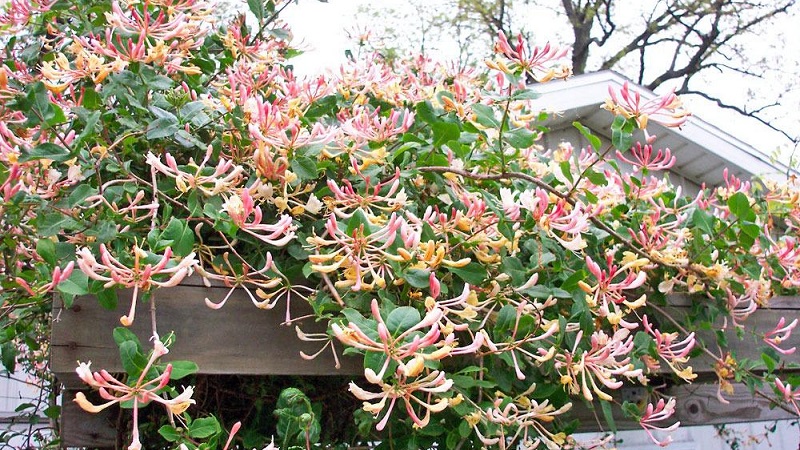
In the second half of summer, small red or orange fruits appear in place of flowers.... Have decorative honeysuckle they are inedible.
It is interesting! Translated from Latin, caprifolium means "goat leaf".
Oval-shaped leaves grow opposite each other and sometimes coalesce around the stem, forming oblong cups. The foliage is usually blue-green, but some varieties have dark green and copper hues.
Care features
Liana easily wraps around any strong support. Where space permits, the bush grows freely. To form a plant, take into account the following features:
- The support for the vines is well strengthened in the ground before planting. Supporting work after the growth of the bush will lead to damage to the roots and death of the plant.
- After regrowth, the vines are placed on a support over the entire taste. Use strips of fabric or other suitable material to secure the individual branches.
- As the branches grow, they stiffen at the base. Pruning 1-2 vines near the ground stimulates the growth of new ones.
- Most of the plants form flower buds in the growth of the current season. Therefore, pruning promotes more lush flowering.
The best time for formative trimming - late autumn or early spring... At the same time, weak or damaged stems are removed. If you want to completely renew the old bush in early spring, cut the plant at a height of about 50 cm from the ground.
Honeysuckle in landscape design
The demand for honeysuckle in landscape design is due to its high decorative properties and unpretentiousness. Planted in early spring, the vine grows well in a sunny area or in partial shade, but in the latter case, the flowering will be less lush. The plant is hardy and does not require complex maintenance.
At the same time, honeysuckle not only decorates the garden, but also attracts butterflies, bees and birds - the gardener's natural helpers.
Solitaire landing
Beautifully blooming vine is suitable for vertical specimen plantings... Vines with fragrant flowers and bright greenery will decorate a fence, an arch, an entrance, a gazebo or a terrace. Honeysuckle disguises an unsightly wall of a house or farm building.
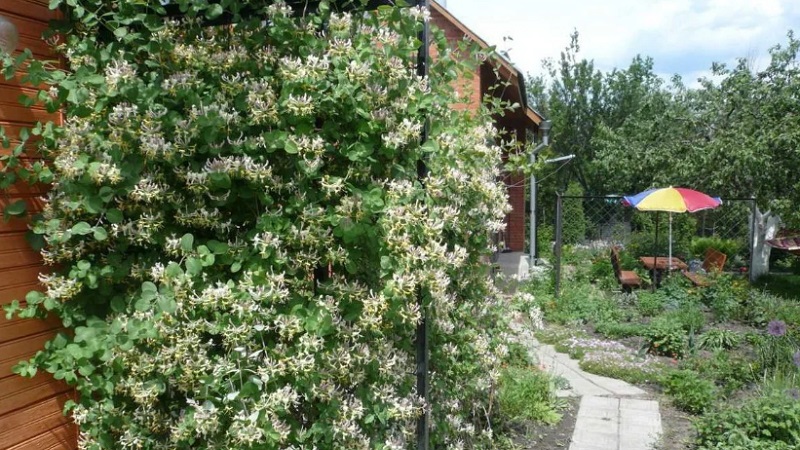
If there is no suitable vertical support, the vines are thrown along the ground, creating a luxurious floral carpet.... Without support honeysuckle grows low - 30–100 cm tall. If the vines are not allowed to grow and are periodically trimmed, cushion thickets densely cover the ground. They fill the space between garden paths, creating a low-maintenance shrub lawn.
Reference.Honeysuckle is grown on hillsides where soil erosion is to be prevented.
Hedge
Lianas planted along the chain-link mesh quickly grow, turning into a hedge... An unsightly stone or concrete fence of the local area is hidden behind such a screen.
In large areas, walls of honeysuckle divide the garden space into independent zones and corners. A playground is surrounded by such a fence, they create a secluded recreation area or receive guests, they hide the neighboring area.
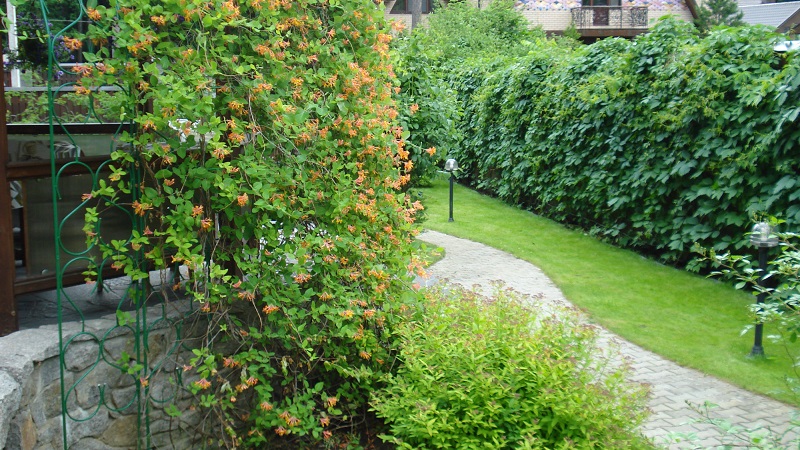
Vines launched on a trellis are able to disguise an unpresentable structure or decorate a facade houses, poles, old stumps, dead trees, etc.
On the trellis
Growing on trellis trellises is another good option for using honeysuckle in landscape design. Such a composition is able not only to decorate the site, but also to zone it or hide unsightly buildings from sight.
Compatibility with other plants
To create complex compositions of flowers and fragrances honeysuckle is combined with other flowering vines: clematis, climbing roses, jasmine, hydrangea, actinidia, curly nasturtium. Gets along well honeysuckle and conifers, but does not like the neighborhood with red and black currants.
Features of the use of different types and varieties
Let's talk about the most common types and varieties of decorative honeysuckle, the features of their use in landscape design.
Honeysuckle
The leader among all varieties of climbing honeysuckle - honeysuckle (Lonicera caprifolium). This is a climbing shrub vine up to 5 m long. Young shoots are bare, light green, on old vines the bark is light brown, exfoliating in longitudinal stripes.
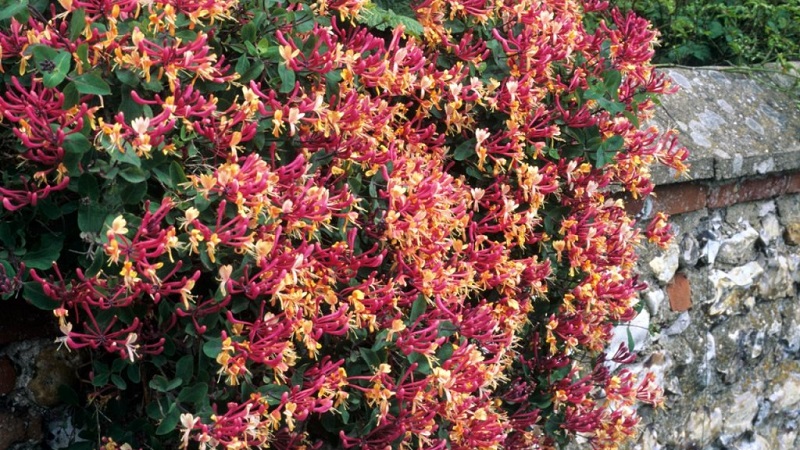
The leaves are distinguished by a pleasant bluish-green color. Flowers are tubular, up to 5 cm long, collected in inflorescences. The upper leaves, growing together in pairs at the bases, form single disc-shaped formations under the flowers. After flowering, orange fruits appear in place of the flowers.
It is interesting! Honeysuckle was first brought to Russia from Europe in the second half of the 19th century. Then the garden pavilions were decorated with flowering lianas.
Honeysuckle blooms magnificently and for a long time, exuding a delicate aroma... Coloring of flowers can be different - from pastel shades to purple and violet.
The unpretentiousness and versatility of honeysuckle explains its popularity. and from contemporary landscape designers. Lianas are used to decorate fences, arches, walls of houses, they are used for zoning areas.
Tatarskaya
Tatar honeysuckle (Lonicera tatarica) is a deciduous shrub 1-3 m high... Gardeners appreciate it for its lush dark greenery and long flowering throughout June. Flowers are painted in white, pink, delicate raspberry shades and are arranged in groups. Fruits are red or orange globular, formed in July – August, inedible.
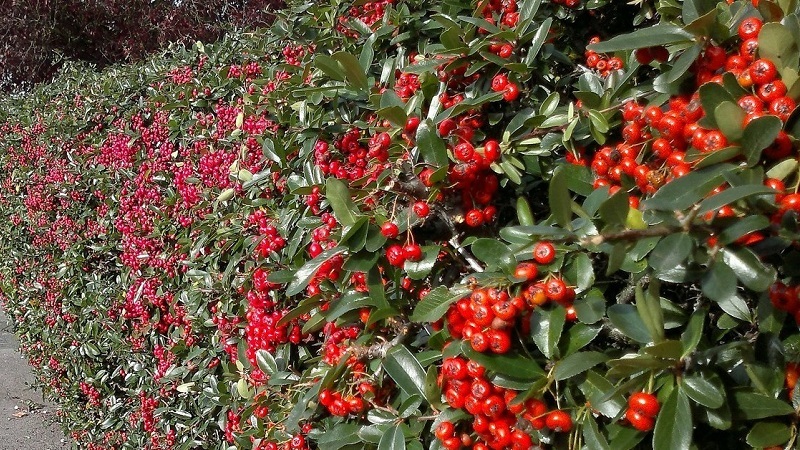
In landscape design, Tatar honeysuckle is used for landscaping city streets and household plots. Bushes in hedges and multi-level compositions are especially attractive. The plant is a good honey plant.
Hat
Cap honeysuckle (Lonicera pileata) does not grow long vines and does not twine around supports, but forms compact heap bushes up to 1.3 m high... This evergreen or semi-evergreen shrub came to Russia from China. Suitable for growing in the south and middle lane.
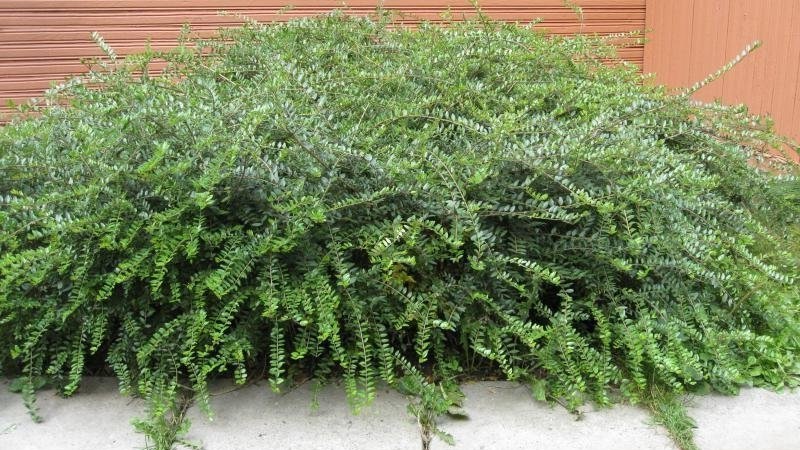
Hat honeysuckle has beautiful not only flowers, but also fruits - red or purple-purple... In landscape design, the shrub is used as a ground cover creeping plant. It looks especially good in the foreground in a composition with conifers. Single bushes are planted on alpine hills and lawns.
Curly
Curly, or German, honeysuckle (Lonicera periclymenum), or forest bean, prized for its sweet-smelling flowers, especially aromatic in the early morning and late evening... They are thin, medium-sized, painted in delicate pastel colors with yellow, pink or purple hues. The fruits are bright red, inedible.

For unpretentiousness, this species is not inferior to honeysuckle, but more thermophilic... It is grown in almost all regions of Russia, except for the north. The vines reach 4-6 m in length. The plant blooms in May - June. Gardeners use decorative varieties of forest bean when decorating hedges, shrub lawns, gazebos, arches.
Coral
Coral, or evergreen, honeysuckle (Lonicera sempervirens) flowers of amazing beauty... During the flowering period, clusters of scarlet tubes with yellow centers are formed on the bush. This is one of the brightest representatives of ornamental honeysuckle. However, the aroma of these flowers is not as intense as, for example, the honeysuckle or forest bean.
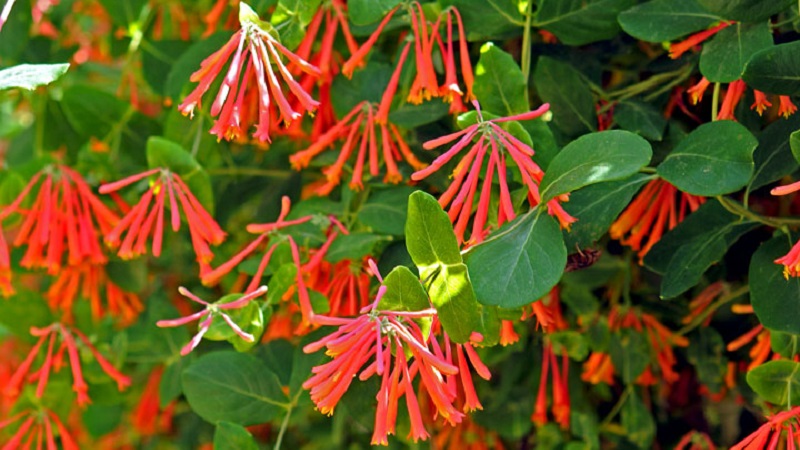
The botanical name of the plant is translated as "evergreen honeysuckle"but this native of the southeastern United States remains evergreen only in its southern regions.
Brown's honeysuckle
Lonicera brownii is a semi-evergreen hybrid obtained by crossing evergreen (L. sempervirens) and rough (L. hirsuta)... Scarlet flowers with an orange center and a light aroma delight the eye from late spring to early autumn.
Attention! Brown's honeysuckle, due to its short stature, is suitable for the design of low hedges and borders. It is grown as a separate bush, in a dense group on the lawn, or as a padding at the foot of tall trees.
Vines grow up to 2 m long... For the winter, most of the leaves do not fall off, remaining under the snow. The flowers are thin, bell-shaped, up to 5 cm long. The color varies from orange-yellow to red and purple, inside the flowers are yellow.
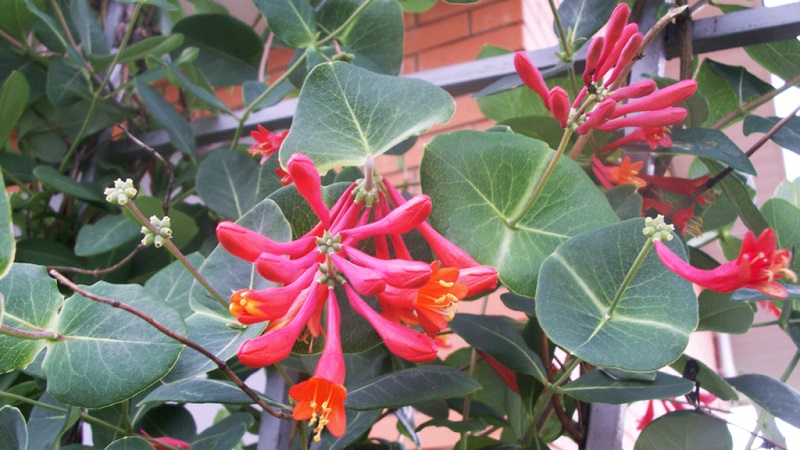
Blooms brown honeysuckle twice a season - in early summer and autumn... It twines loosely around the supports, without them it grows bushy, up to 1 m high.
Honeysuckle Hecrotta
This plant (Lonicera heckrottii) has large, bright flowersresembling tongues of flame. Blooms all summer. The buds are carmine, but as soon as they open, they turn pink, with a purple hue on the outside and golden yellow on the inside.
Honeysuckle Hecrotta — highly curly hybrid with vines up to 4 m long... The leaves are elongated, up to 7 cm long, dark green, glaucous below. The culture loves warmth; when grown in central Russia, flowering is not as abundant as in the south.
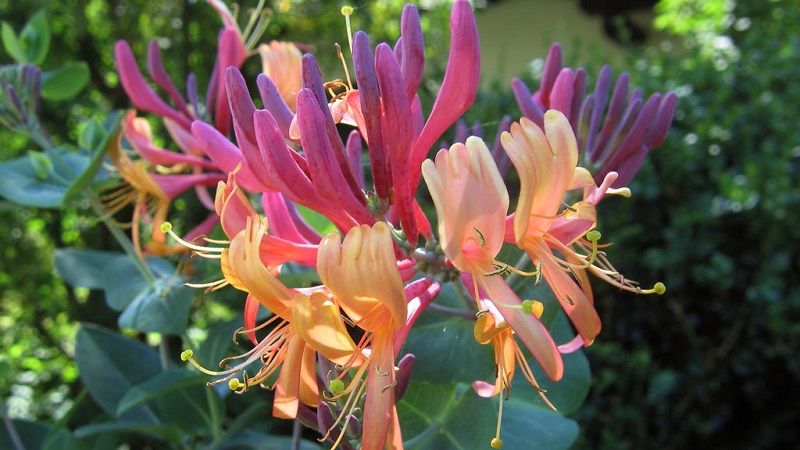
Long vines are suitable for decorating high arches, fences, gazebos, walls of houses... The plant is used as a ground cover shrub for sodding empty slopes.
Yellow
Yellow honeysuckle (Lonicera flava) - slightly curling shrub variety... Shoots grow up to 3 m long. Leaves are bright green, broadly elliptical, up to 8 cm long, leathery, bluish-green below. The upper leaves grow together in bases into one oval disc.
The flowers are bright, orange-yellow, with an intense aroma, collected in capitate inflorescences at the ends of the shoots. Formed in June, last about 20 days. In the southern regions, the culture hibernates without shelter.

Small creepers of yellow honeysuckle are good for decoration of low mesh fences, hedges, curbs, foot of tall trees.
Japanese
Japanese honeysuckle (Lonicera japonica) differs from congeners in rapid growth (annual growth is 1–1.5 m)... Vines grow up to 6 m long. It is important to consider that this aggressive shrub displaces all nearby plants.
This species is appreciated for its lush flowering and pronounced aroma.... Japanese honeysuckle Kansas is good for large area design, where it is used both in vertical landscaping and as a ground cover plant. Halliana variety is unpretentious and blooms even on scarce soils and in partial shade.
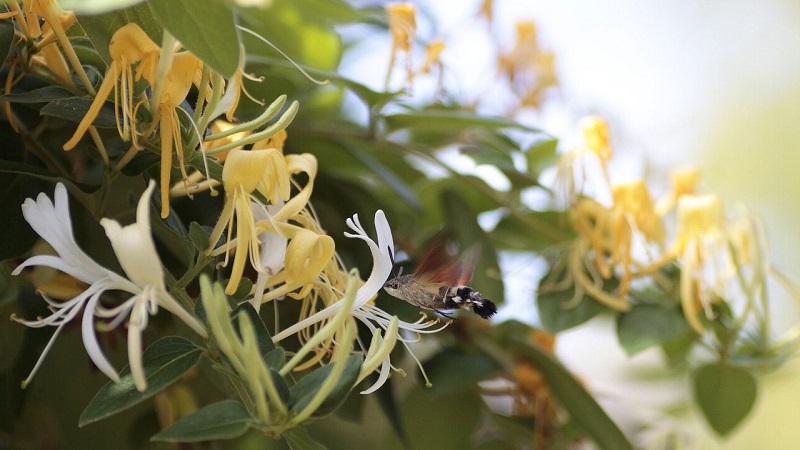
Reviews
Here are a few reviews of gardeners who grow decorative honeysuckle on plots.
Irina, P. Shkolny: “I grow honeysuckle, honeysuckle, Alba variety. Planted a couple of years ago, now it annually pleases us with beautiful flowering and incomparable aroma. Suitable for both vertical gardening of the site, and for horizontal. In my case, this is the arch at the entrance, on which Alba feels very comfortable ".
Valentina, Volgograd: “I bought a Kansas honeysuckle root a few years ago and use it in my garden seating area. During the very first summer, it expanded by 5 m. And I did not immediately put up a support, and the vines twisted around myself and everything that was around. It turned out to be a wonderful decoration of the far corner of the garden ".
Nadezhda, Anapa: “I remember this plant from childhood. At our dacha, honeysuckle curled along the walls of the house. My bed was by the window, and in the morning I woke up from a fresh breeze with an unusually sweet aroma. Now that I have my own house, I also planted this wonderful loach in the garden and I do not regret it a bit. The care for the honeysuckle is minimal and the effect is amazing. Watering, tying up - that's all she needs ".
Conclusion
Curly varieties of honeysuckle are a good choice for decorating gazebos and arches, fences and tree trunks. Lush bloom pleases the eye and fills the air with a magical aroma. In addition to decoration, the plant also performs useful tasks in landscape design - it places bright accents and disguises unattractive objects on the site.